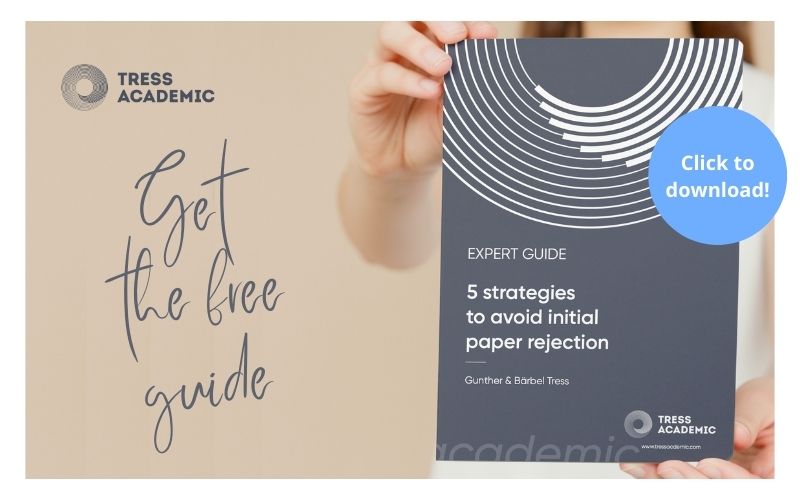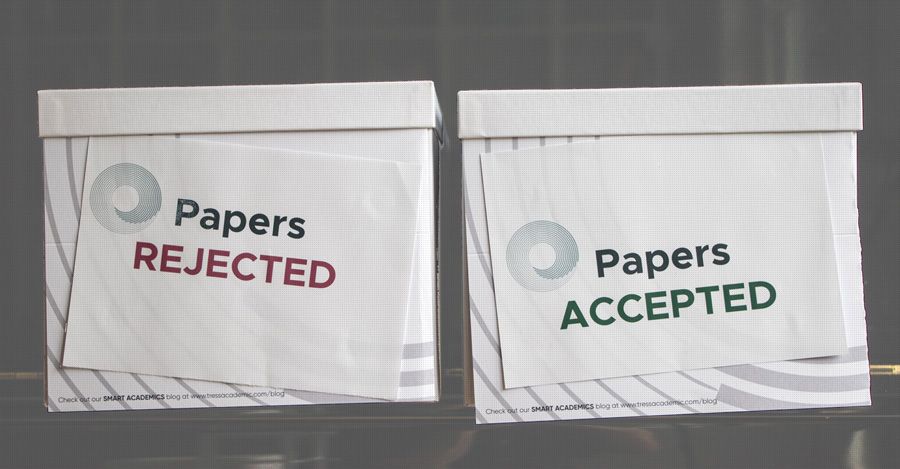You probably think that if your paper gets rejected, it’s simply not good enough. But do you know why papers get rejected? In fact, there are a lot of reasons why journal editors may decline your paper. ‘Not good enough’ is a very broad description for a set of varying reasons that can lead to rejection. And if you know the reasons from the start, you can easily avoid them. Get an overview of the most common reasons for rejection here, and take the test to see if your paper is likely in danger of being rejected!
Have you considered getting rejected?
In this post, we’ll look at a common fear many authors have: the fear of rejection. Specifically, we’ll talk about being rejected from international, peer-reviewed journals. We know this fear can curb all positive motivation for writing your paper. You end up thinking: if it might get declined anyways, why do all the hard work to have it end up in the bin?
But you can do something about it! The better you know what factors could lead to rejection, the better equipped you’ll be for submitting, and the better your chances for getting accepted.
In this article, we’ll discuss 25 reasons why a paper could get rejected. Once you know them, you can make sure to avoid them and get your paper published. We also offer a free worksheet to self-assess how likely your paper is for rejection: “Assessing rejection risk”.
Reasons why a paper can get rejected:
1. Out of scope
A very common, and universal reason, “out of scope” means that editors just don’t think that your paper fits their journal. Either the topic itself, or the type of study is not appealing enough to the journal’s readers. The upside of this is that it doesn’t necessarily mean anything is ‘wrong’ with your paper. The downside is that you submitted to the wrong journal.
2. Lacking state-of-the-art overview
A journal will also reject your paper if they feel that you’re not keeping up well enough with the ongoing research in your field. They think that, if you don’t know and showcase what other researchers are doing, or have done, in the field, you might have missed important developments that could affect your research.
3. Lack of originality
Rejection also happens if your paper doesn’t present any new findings, concepts or methods. The journal might even send you a reference to another paper, in which someone has already presented your same findings. For the readers, this would only be a déjà-vu, and therefore boring.

4. Lack of conclusion
In your paper, you must not only report your research question and findings, but also give your readers something to walk away with, and to have learned. If such a take-home message is missing, your paper can get rejected, because readers might wonder what the point was, or what they were supposed to have learned.
5. Flaws in research design or methods
This is probably the most common reason for papers getting rejected. Editors and reviewers keep a close eye on the way you approach your research question. This screening is essential to ensure the validity of your work. Minor issues with methods can be dealt with in a revision, but if major problems are found and cannot be addressed, or if substantial information about methods is missing, a rejection is likely.
6. Unclear research question
This type of rejection occurs when your paper focuses too much on what you did in your project without properly informing readers about the research question behind it. It might be completely clear for you, as the author, why and what you want to achieve with your paper, but this information is vital for your readers to understand as well.
7. Redundant publication
If you try to republish findings that you’ve already published, it will be considered repetition, and get rejected. Re-publishing raises an issue of originality, which is a key aspect journals strive for.

8. Lack of relevance
The page space in journals is limited, as is the interest and time commitment of a journal’s reader base. Therefore, it’s vital for a journal to publish only papers which have high relevance to their audience. If the journal editor can’t see the relevance of your paper for their audience, it’s unlikely they will publish it.
9. Lack of international importance
Most journals are read all across the globe, and your peers are likewise located all around the world. An editor needs to assess whether your paper is of interest, not just to readers from your country or region, but to a wider, global audience. If there’s no lesson for international readers to learn from your paper, it might get declined.
10. Unsuitable paper topic
Not every topic is suitable for publication in journals. Journals have preferences for the topics they publish, which are often specified in their guidelines. For papers outside these topic areas, it can be more difficult to be considered.
11. Unclear target audience
If editors cannot identify a clear target audience for your paper, especially one that fits inside the readership of their journals, they will not consider your work. It’s not enough to assume that your paper is interesting for everybody in your field, because this could also mean that it’s interesting to nobody.
12. Ethical conflicts
Papers that deal with ethical problems or which seem to be built on ethically incorrect behaviour, especially those that don’t take these problems on with a critical eye, will most likely not be considered.
13. Lacking paper message
If, after reading your paper, a reader, an editor or a reviewer is in doubt about what the message of your paper actually is, the journal will decline publication. Every author should communicate a message to their readers, and if this message can’t be found or understood, publication is not an option.
14. Presenting preliminary results
Sometimes, authors are not 100% sure about the accuracy of their results, which is fine. But if you, from the start, only present preliminary findings, while knowing that your final results might be different, journals will not be interested in your work. What should readers do with your paper if your final results end up being different then your published, preliminary ones?
15. Lack of editing
If your text is hard to read, difficult to understand, repetitive, lengthy, or requires several re-reads in order to be understood, you make it extra difficult for a journal to accept your paper.
16. Formal requirements ignored
If your submission does not adhere to the formal requirements of the specific journal you’re submitting to, you take the risk that editors won’t even look at your text. Ignoring journal requirements simply means that you’ve wasted the possibility of getting published in the journal of your choice.
17. Problems with language and style
A paper that cannot be understood or is difficult to read will most likely not be considered. Don’t assume that good research will make up for poor language and style.
18. Poor response to reviewers
If you ignore, disagree or turn down all suggestions from reviewers, or if you try to negotiate your way through peer-review, you risk getting rejected. Reviewers spend a lot of time creating feedback for papers and might react negatively if you don’t respond to their suggestions.
19. Lack of focus
A paper that tries to deal with too many questions and problems at the same time is naturally lacking in focus. The journal and its readers may have difficulty understanding what your contribution is, and could turn down your paper.
20. Questions left unanswered
If your paper presents a research question which it fails to provide an answer to, it will get rejected. It’s like promising something without ever delivering it.
21. Paper length
If your paper is very long and repetitive in parts, readers will not enjoy it, and editors may therefore decide to decline it from the start.
22. Invalid results
If your results are not robust and reliable, your findings can be perceived as a suggestion rather than an answer to your research question. For your peers, such a paper is of low value, as they can’t build on it or relate their findings to yours. Editors will decline papers with such results.
23. Lacking interpretation of results
In addition, results without interpretation are meaningless. If your paper makes no attempt to explain, discuss or justify your results in the wider context, it will be looked at negatively by reviewers, editors and peers, and will likely be declined.
24. Lack of critical reflection of methods
In a perfect world, you would have all the resources and knowledge that you needed available to you in order to address your paper’s research question in the best way possible. But in reality, this is not always the case.Therefore, there are some limitations that require you to use critical reflection towards your methods. If you’re unaware of, or ignoring potential limitations, you risk rejection.
25. One more
There are definitely many more reasons why a paper could be rejected. If you’ve experienced any reasons that aren’t listed here, send us a message at info@tressacademic.com . We’d love to hear your experiences!
Conclusion
Now, we don’t want you to feel discouraged and think “Oh dear, all those things could happen? Should I actually submit a paper at all? There are so many reasons why the journal could turn down my paper!”
Yes, you should prepare and submit a paper! It’s not guaranteed that every single reason on this list will automatically lead to rejection. Often, editors will reject a paper for several reasons. But now, since you know what could happen, you can prepare yourself to write your paper in a way that this will NOT happen to you.
If you’re uncertain about how likely your paper is to fall into one of these categories, download our free worksheet “Assessing rejection risk”. It’ll help you identify which aspects you should improve to protect your paper against the risk of rejection.
The great thing is that all of the above-mentioned reasons for rejection can be avoided. We have provided a wide array of tools, guidelines and worksheets to help you with these problems (have a look at the relevant resources below). If you want to learn, step-by-step, how to get around all of these common errors and write your paper in the most efficient way, sign-up for our next paper-writing course. It covers all the topics above, and guides you smoothly through the paper-writing process.

Relevant resources:
- Free worksheet: “Assessing rejection risk”
- Expert Guide: 5 strategies to avoid initial paper rejection
- Blog post #9: What reviewers of your paper first look at
- Blog post #25: Suggesting reviewers for your paper: rules to consider
- Blog post #32: How NOT to react when you receive review reports
- Blog post #34: Seven features of a good response to reviewers
- Blog post #40: Lessons learned from our paper-writing students!
- Blog post #42: My paper got rejected! What now?
- Blog post #45: 20 great ways to stay productive when Corona (COVID-19) has locked you out of university
- Blog post #49: 15 steps to get a paper written during the Corona lockdown
- Blog post #50: Mastering the literature review during the Corona lockdown
More information:
Do you want to successfully publish your paper? If so, please sign up to receive our free guides.
© 2020 Tress Academic
#PaperWriting, #JournalPaper, #PaperRejection, #PeerReview,
